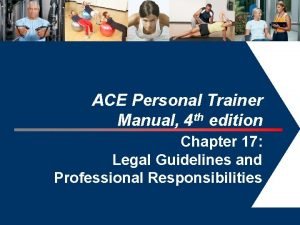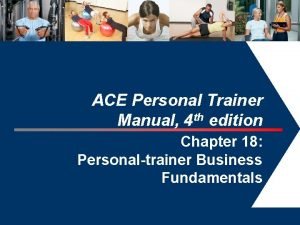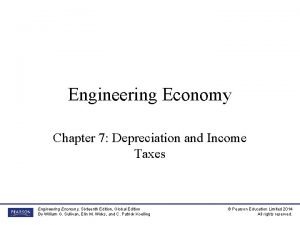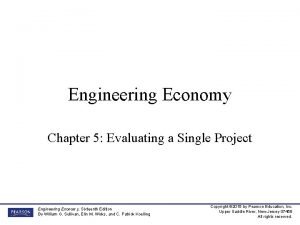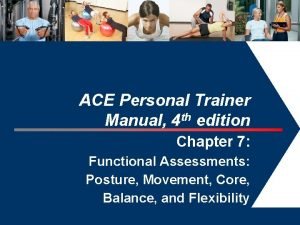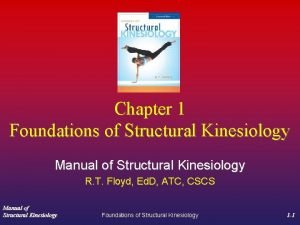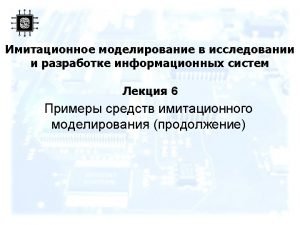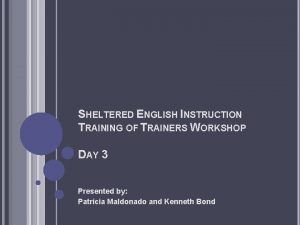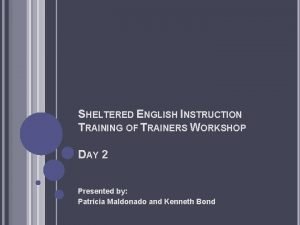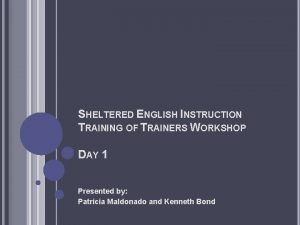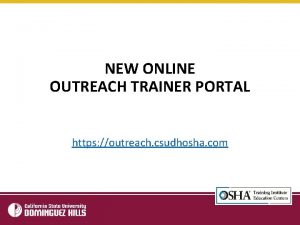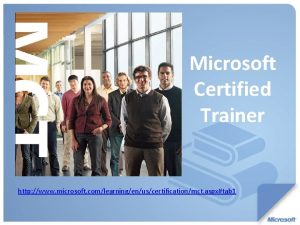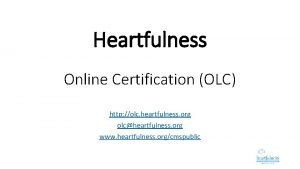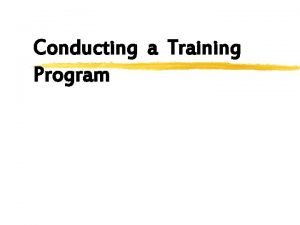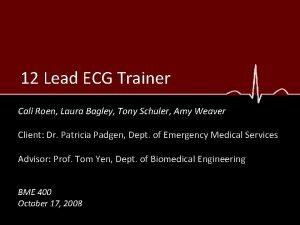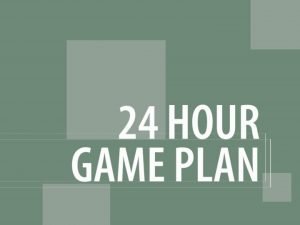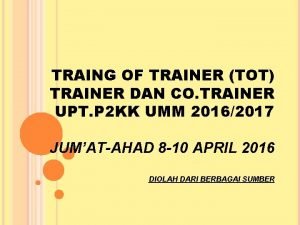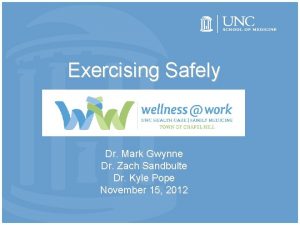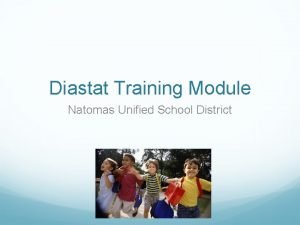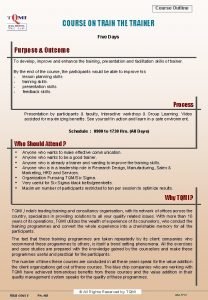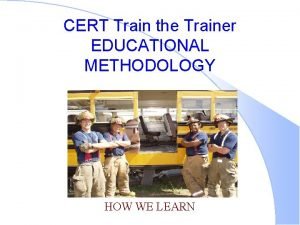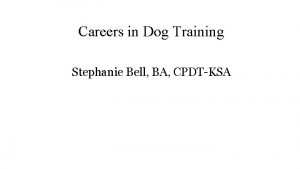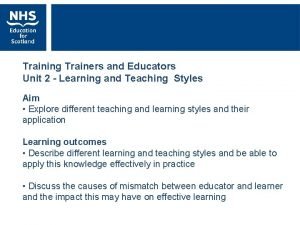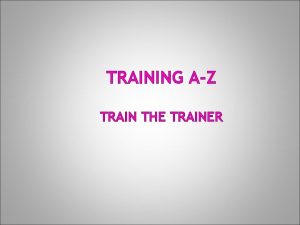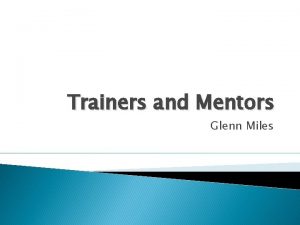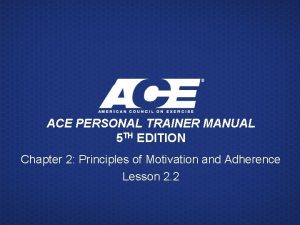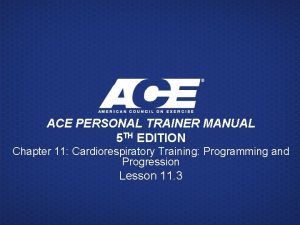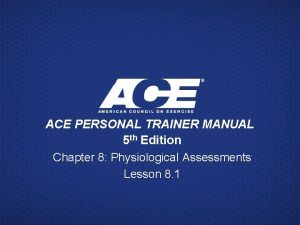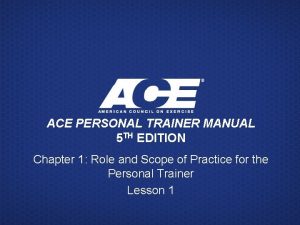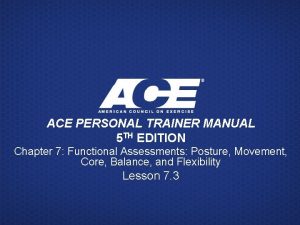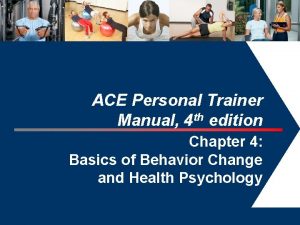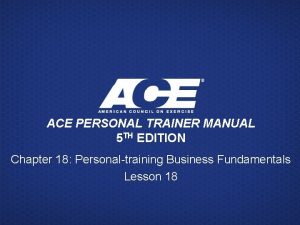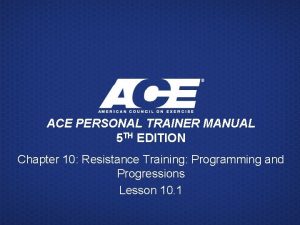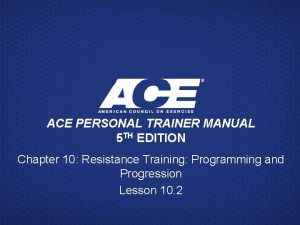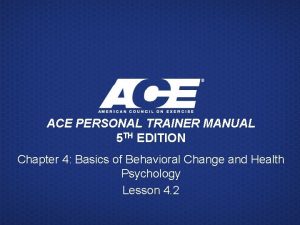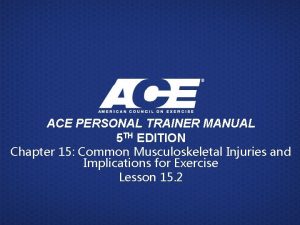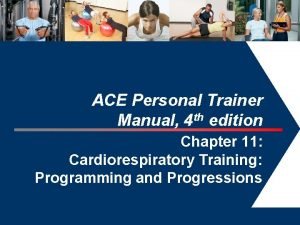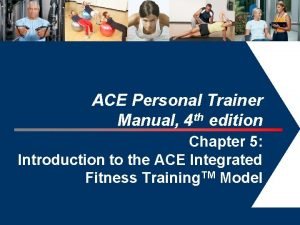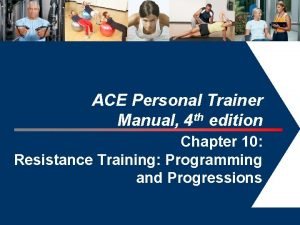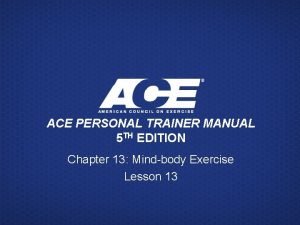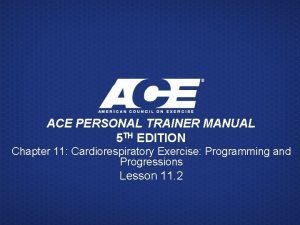ACE PERSONAL TRAINER MANUAL 5 th Edition Chapter






































- Slides: 38

ACE PERSONAL TRAINER MANUAL 5 th Edition Chapter 9: Functional Programming for Stability-Mobility and Movement Lesson 9. 3

LEARNING OBJECTIVES • After completing this session, you will be able to: ü Discuss balance: static vs. dynamic balance, training guidelines, and the effect on center of gravity and line of gravity ü Discuss the importance of single-leg stand patterns, and demonstrate exercises to promote stability and dynamic movement patterns ü Describe the importance of training the five basic movement patterns, and the effects each have in the kinetic chain and activities of daily living ü Discuss bend-and-lift and single leg movement patterns, and demonstrate exercises that promote proper movement for each ü Discuss pushing and pulling movement patterns, and demonstrate exercises that promote proper movement for each ü Discuss rotational movement patterns, and demonstrate exercises that promote proper movement © 2014 ACE

BALANCE • Movement is essential to complete all activities of daily living (ADL) – the ability to move efficiently requires control of the body’s postural alignment • Balance: ü ü The foundational element of all programming Enhances physical performance A trainable skill – improvements are evident with a few weeks Builds self-efficacy and confidence • Two types: ü Static balance – the ability to maintain the body’s center of mass (COM) within its base of support (BOS) ü Dynamic balance – the ability to move the body’s COM outside of its BOS while maintaining postural control and establishing a new BOS © 2014 ACE

STATIC BALANCE • COM, or center of gravity (COG) – represents that point around which all weight is evenly distributed: ü A person’s COG constantly shifts as he or she changes position, moves, or adds external resistance. © 2014 ACE

STATIC BALANCE • Base of support (BOS) – the two-dimensional distance between and beneath the body’s points of contact with a surface: ü Moving the feet closer together reduces the BOS and the balance control • Line of gravity (LOG) – a theoretical vertical line passing through the COG, dissecting the body into sagittal and frontal planes: ü The body is considered stable when its line of gravity (LOG) falls within its BOS • Balance is more challenging when the LOG or the COG falls near, or outside of, the BOS, or when one challenges the body’s limits of stability (LOS): ü LOS is the degree of allowable sway away from the line of gravity that can be tolerated without a need to change the BOS © 2014 ACE

LINE OF GRAVITY © 2014 ACE

GUIDELINES FOR STATIC BALANCE © 2014 ACE

DYNAMIC BALANCE • Different surfaces create a challenge in training balance. • Unstable, static balance-training devices (and the ground) are proactive – clients can generally anticipate the balance requirements • Dynamic, unstable devices are reactive – the client must react to the changing surface ü Both forms develop proprioceptive (somatosensory), vestibular, and ocular (visual) system efficiency © 2014 ACE

SINGLE-LEG STAND PATTERNS • Standing on a single leg requires: ü Stability in the stance-leg, hip, and torso ü Mobility in the raised leg if stepping is involved ü Hip abductor weakness reflects an inability to control lateral hip shift, placing additional stress on the knee • Before learning single-leg movements, clients should: ü Strengthen hip abductors in isolation before integrating full-body, weightbearing movements ü Learn how to effectively control hip adduction and demonstrate control of lateral shifts during gait © 2014 ACE

SINGLE-LEG STANDS • Objective: promote stability within the stance-leg and hip during a single-leg stand © 2014 ACE

STATIC BALANCE ON A SINGLE LEG • Once a client can effectively stand on one leg: ü Introduce dynamic movements of the upper and lower extremity over a static base of support ü Introduce various forms of resistance (e. g. , medicine balls, cables, or bands) to increase stabilization demands and the need for bracing • A personal trainer’s creativity is important to heighten the fun factor: ü Always exercise common sense ü Keep drills skill- and conditioning-level appropriate ü Keep exercises purposeful © 2014 ACE

DYNAMIC MOVEMENT PATTERNS © 2014 ACE

DYNAMIC MOVEMENT PATTERNS © 2014 ACE

DYNAMIC MOVEMENT PATTERNS OVER A STATIC BASE © 2014 ACE

DYNAMIC MOVEMENT PATTERNS OVER A STATIC BASE © 2014 ACE

PHASE 2: MOVEMENT TRAINING • This phase of training involves teaching patterns for five primary movements: ü Using body weight as resistance ü Using the levers within the body (e. g. , the arms) as drivers to increase exercise intensity • By performing the five movements effectively: ü The potential for efficient movement is increased ü The likelihood for compensation, pain, and injury is decreased • Many factors affect the timeframe to successfully train the five movements. © 2014 ACE

NORMAL HIP POSITION © 2014 ACE

BEND-AND-LIFT PATTERNS • The bend-and-lift movement associated with the squat is one of the most prevalent activities used in strength training and throughout most individuals’ ADL. • Proper technique is key: ü Faulty movement patterns associated with poor technique will disrupt muscle function and joint loading. o This compromises performance and ultimately leads to overload and potential injury ü The inability to stabilize the lumbar spine or maintain a straight or slightly extended thoracic spine increases compressive and shear forces on the lumbar vertebrae. ü With inadequate thoracic spine mobility, movement compensation occurs involving increased lumbar extension. ü Squatting (with external loads) with excessive lumbar extension dramatically increases the compressive forces on the lumbar spine. © 2014 ACE

HIP HINGE • Objective: emphasize “glute dominance” over “quad dominance” during the initial 10 to 15 degrees of movement © 2014 ACE

LOWER-EXTREMITY ALIGNMENT • Objective: promote alignment among the hips, knees, and feet during a bend-and-lift movement © 2014 ACE

FIGURE-4 POSITION • Objective: promote optimal alignment between the trunk and tibia, as well as optimal position of the spine © 2014 ACE

SINGLE-LEG MOVEMENT PATTERNS • Progression for the single-leg stance involves: ü Adding external resistance – such as holding a medicine ball or dumbbell ü Increasing the balance challenge – such as introducing partial single-leg squat • The traditional lunge, and lunge variations – occur in ADL, workouts, and sports: ü Clients should be trained functionally to mimic these patterns • Once proficient with the standard lunge pattern, progress the exercise to include: ü Directional changes ü Different foot positions ü Upper-extremity movement © 2014 ACE

HALF-KNEELING LUNGE RISE • Objective: teach the proper mechanics of the rising portion of the lunge © 2014 ACE

LUNGES • Objective: teach the proper mechanics of the full lunge © 2014 ACE

LUNGE MATRIX • Objective: promote stability and mobility throughout the kinetic chain using variations of the standard lunge © 2014 ACE

LUNGE MATRIX © 2014 ACE

PUSHING MOVEMENTS • Scapular rotation and stability is critical for various pushing movements. • The emphasis of training during phase 2 – shift from isolated shoulder exercises toward integrated whole-body movement patterns: ü Exercises can begin with more traditional pushing movements ü Exercises may target the shoulder girdle bilaterally or unilaterally ü Use supported backrests, then progress to unsupported movements to mimic ADL © 2014 ACE

SCAPULAR MOVEMENT © 2014 ACE

BILATERAL AND UNILATERAL PRESSES • Objective: execute open-chain pushing movements in unsupported environments without compromising stability in the scapulothoracic joint and lumbar spine © 2014 ACE

THORACIC MATRIX • Objective: promote multiplanar thoracic mobility with drivers (e. g. , arms or a dowel or lightly weighted bar) while stabilizing the kinetic chain © 2014 ACE

OVERHEAD PRESS • Objective: provide additional stability to the shoulder capsule during the lowering phase of overhead pressing movements © 2014 ACE

PULLING MOVEMENTS • Pulling movements follow similar principles to pushing with regard to scapulothoracic stabilization – which promotes better glenohumeral function. • A client can: ü Pull from a position of scapular stability, implying that the movement is purely from the shoulder ü Pull and intentionally incorporate scapular retraction into the movement • The emphasis of training during phase 2 – shift from isolated shoulder exercises toward integrated whole-body movement patterns: ü Exercises can begin with more traditional pulling movements ü Exercises may target the shoulder girdle bilaterally or unilaterally ü Use supported backrests, then progress to unsupported movements to mimic ADL © 2014 ACE

BILATERAL AND UNILATERAL ROWS • Objective: execute open-kinetic-chain pulling movements in unsupported environments without compromising stability of the scapulothoracic joint and lumbar spine © 2014 ACE

ROTATIONAL MOVEMENTS • Rotational movements: ü Are very complex due to the spiral or diagonal patterns throughout the body ü Generally incorporate movement into multiple planes simultaneously ü Increase the forces placed along the vertebrae and require effective core conditioning ü Require technique and appropriate mobility and stability levels in the thoracic and lumbar spine to facilitate synchronous movement ü The ability to dissipate ground and reactive forces reduces the impact on local areas and decreases the potential for injury. • Two key movements involving diagonal or spiral patterns of movement within the arms, shoulders, trunks, hips, and legs: ü Wood chop ü Hay baler © 2014 ACE

WOOD-CHOP AND HAY BALER SPIRAL PATTERNS • © 2014 ACE Objective: introduce basic spiral patterns with small, controlled forces placed along the spine

WOOD-CHOP AND HAY BALER SPIRAL PATTERNS © 2014 ACE

WOOD-CHOP AND HAY BALER • Objective: add external resistance from a cable or elastic resistance to the full wood-chop/hay baler patterns © 2014 ACE

SUMMARY • Trainers should emphasize stability and mobility during the initial phase of a client’s training program to restore good joint alignment and muscle balance across joints. • Trainers must stress the importance of learning how to perform the five basic movement patterns correctly: ü ü ü Bend-and-lift movements (e. g. , squatting) Single-leg movements (e. g. , single-leg stance and lunging) Pushing movements Pulling movements Rotational (spiral) movements • Proper execution of these movements enhances the potential to promote movement efficiency, as well as long-term maintenance and integrity of the joint structures, muscles, connective tissues, and nerves of the musculoskeletal system. © 2014 ACE
 Personal training insurance ace
Personal training insurance ace Personal trainer swot analysis
Personal trainer swot analysis Engineering economy 16th edition solution manual chapter 5
Engineering economy 16th edition solution manual chapter 5 Engineering economy 16th edition chapter 5 solutions
Engineering economy 16th edition chapter 5 solutions Engineering economy 16th edition solution manual chapter 3
Engineering economy 16th edition solution manual chapter 3 Malleleous
Malleleous Mis chapter 6
Mis chapter 6 Zulily case study
Zulily case study Manual of structural kinesiology 18th edition
Manual of structural kinesiology 18th edition Personal finance 6th edition
Personal finance 6th edition Anylogic personal learning edition
Anylogic personal learning edition How to be a good trainer
How to be a good trainer Train the trainer course objectives
Train the trainer course objectives Luke trainer clark the boy who cried wolf
Luke trainer clark the boy who cried wolf Sheltered trainer
Sheltered trainer Sheltered trainers
Sheltered trainers Sheltered 2 trainer
Sheltered 2 trainer Ospfv
Ospfv Portal 2 trainer
Portal 2 trainer Microsoft certified trainer login
Microsoft certified trainer login Azure technical trainer
Azure technical trainer Heartfulness.org login
Heartfulness.org login Good trainer qualities
Good trainer qualities Example of malfeasance in athletic training
Example of malfeasance in athletic training 12 lead trainer
12 lead trainer Escape simulator guide
Escape simulator guide Sce siemens
Sce siemens Microsoft innovative educator trainer academy
Microsoft innovative educator trainer academy Executive team trainer
Executive team trainer Co trainer adalah
Co trainer adalah Globe trainer
Globe trainer Zach morgan trainer
Zach morgan trainer Diastat trainer
Diastat trainer Train the trainer course outline
Train the trainer course outline Cert train the trainer
Cert train the trainer Self-employed dog trainer salary
Self-employed dog trainer salary Sheltered 2 trainer
Sheltered 2 trainer Train the trainer agenda
Train the trainer agenda Qualities of a good trainer
Qualities of a good trainer
